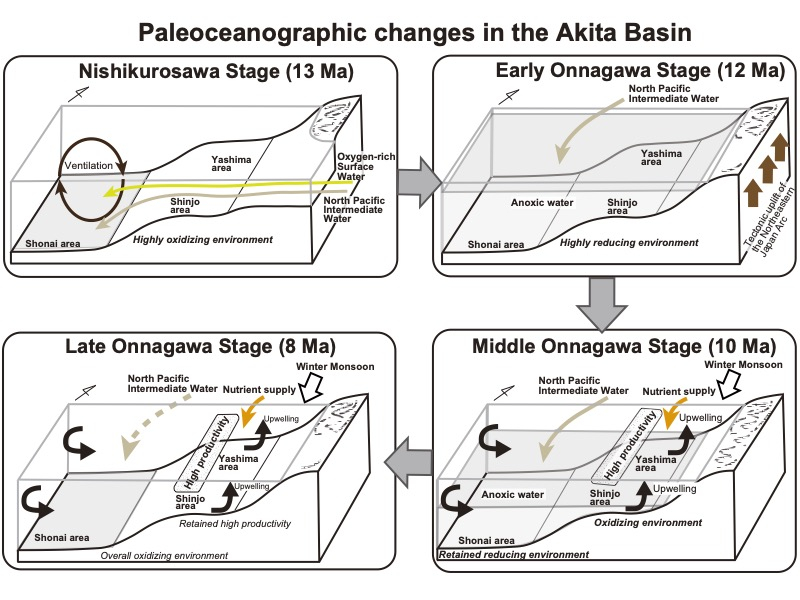
Spatio-temporal changes in the depositional environment of Miocene organic rich mudstones in the Akita Basin deduced from biomarker analysis
ABSTRACT

Paleoceanographic changes in the Akita Basin during the Miocene were investigated using biomarker analysis of source rocks from the Onnagawa and Kusanagi formations in the Yashima area (eastern basin margin) and the Shonai Plain (central basin). During the Nishikurosawa Stage (~13 Ma), the homohopane index indicated a slightly oxidizing depositional environment. At this time, the Japan Sea was an open marginal sea and an oxidizing environment; thus, organic matter preservation in the Akita Basin was low. In the Early Onnagawa Stage (~12 Ma), the Japan Sea became semi-closed because of uplift of the proto-Northeastern Japan Arc. This change is reflected in the pristane/phytane ratio and homohopane index that suggest the Yashima and Shonai Plain areas became reducing, which enhanced organic matter preservation. The depositional environment of the Kusanagi Formation (Shonai Plain) was more reducing than that of the Onnagawa Formation (Yashima area). During the Middle Onnagawa Stage (10 Ma), the homohopane index showed that the Onnagawa Formation (Yashima area) had shifted to an oxidizing depositional environment. Additionally, the C27/C27 + C29 sterane ratio indicated that algae were responsible for the higher overall primary production in the Middle Onnagawa Stage. This high primary productivity was associated with localized coastal upwelling, which resulted in generally high organic matter content in the Middle Onnagawa Formation. In the Shonai Plain area (Kusanagi Formation), bottom water conditions remained anoxic; however, sedimentary organic matter content did not increase because there was no upwelling in the area. During the Late Onnagawa Stage (8 Ma), the seafloor environment in the Shonai Plain area also became oxidizing. As a result of enhanced organic matter decomposition, overall sedimentary organic matter content decreased.
KEYWORDS
Paleoceanographic change, Akita Basin, Coastal upwelling, Depositional environment, Biomarker analysis- Published : 2022
- Released on J-STAGE : 2022/02/28
- Received : 2021/02/25
- Accepted : 2021/08/27
- DOI : https://doi.org/10.2343/geochemj.GJ22001
- J-STAGE URL : https://www.jstage.jst.go.jp/article/geochemj/56/1/56_GJ22001/_article/-char/ja
- J-Online ISSN: 1880-5973
- Print ISSN : 0016-7002
- ISSN-L : 0016-7002
All Issues
- Vol.59, 2025
- Vol.58, 2024
- Vol.57, 2023
- Vol.56, 2022
- Vol.55, 2021
- Vol.54, 2020
- Vol.53, 2019
- Vol.52, 2018
- Vol.51, 2017
- Vol.50, 2016
- Vol.49, 2015
- Vol.48, 2014
- Vol.47, 2013
- Vol.46, 2012
- Vol.45, 2011
- Vol.44, 2010
- Vol.43, 2009
- Vol.42, 2008
- Vol.41, 2007
- Vol.40, 2006
- Vol.39, 2005
- Vol.38, 2004
- Vol.37, 2003
- Vol.36, 2002
- Vol.35, 2001
- Vol.34, 2000
- Vol.33, 1999
- Vol.32, 1998
- Vol.31, 1997
- Vol.30, 1996
- Vol.29, 1995
- Vol.28, 1994
- Vol.27, 1993
- Vol.26, 1992
- Vol.25, 1991
- Vol.24, 1990
- Vol.23, 1989
- Vol.22, 1988
- Vol.21, 1987
- Vol.20, 1986
- Vol.19, 1985-1986
- Vol.18, 1984
- Vol.17, 1983
- Vol.16, 1982
- Vol.15, 1981
- Vol.14, 1980
- Vol.13, 1979
- Vol.12, 1978
- Vol.11, 1977
- Vol.10, 1976
- Vol.9, 1975
- Vol.8, 1974
- Vol.7, 1973
- Vol.6, 1972-1973
- Vol.5, 1971
- Vol.4, 1970-1971
- Vol.3, 1969-1970
- Vol.2, 1968
- Vol.1, 1966-1967




